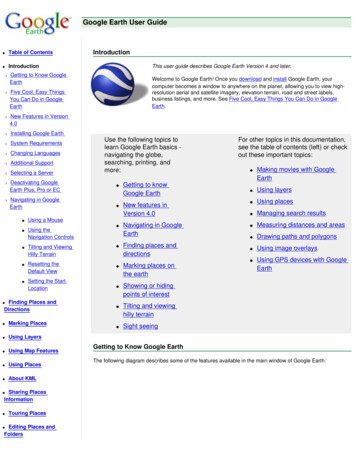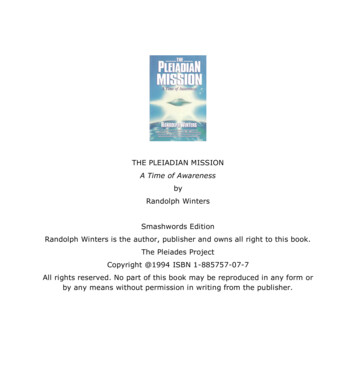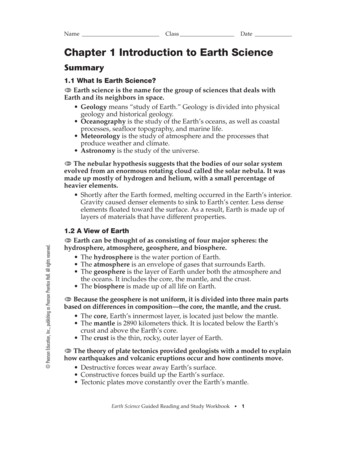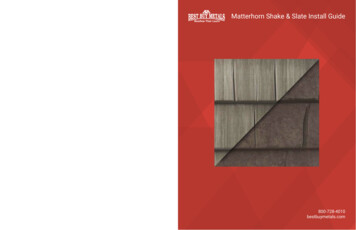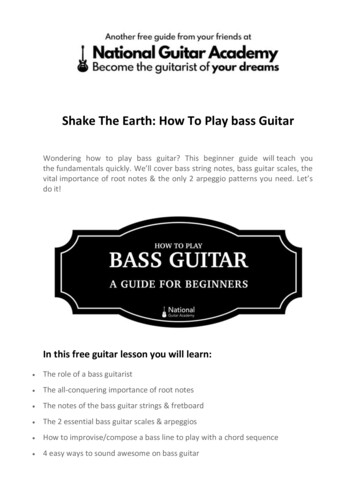
Transcription
Shake The Earth: How To Play bass GuitarWondering how to play bass guitar? This beginner guide will teach youthe fundamentals quickly. We’ll cover bass string notes, bass guitar scales, thevital importance of root notes & the only 2 arpeggio patterns you need. Let’sdo it!In this free guitar lesson you will learn: The role of a bass guitarist The all-conquering importance of root notes The notes of the bass guitar strings & fretboard The 2 essential bass guitar scales & arpeggios How to improvise/compose a bass line to play with a chord sequence 4 easy ways to sound awesome on bass guitar
How To Play Bass Guitar: IntroductionOnce upon a time there were no bass guitars.If you wanted to be the bass player in a band, it meant lugging one of thosehuge upright double-basses you see in orchestras and jazz bands to and fromband practice.Then one day, the good folks at Fender saved all our backs and brought out aguitar version of the bass!Hey presto, it became possible to learn how to play bass guitar.There are 4 strings on a bass guitar. Each string has aname AND a number.To learn how to play bass guitar you’ll need to know the notes of thestrings. The four strings of a bass guitar are tuned the same as the lower fourstrings of an ordinary guitar.
The thickest string is the 4th string. This is tuned to E. We often refer to this asthe ‘low E string‘. This is the deepest/lowest bass note you can play. The 3rd string is tuned to A, so it’s usually referred to as the A string. The 2nd string is tuned to D, so it’s usually referred to as the D string. The thinnest string is the 1st string and it’s tuned to G, so it’s usually referredto as the G string.These notes are the same as a standard guitar but they’re an octave lower. Inlayman’s terms, this means they sound deeper and lower and . Well, bassier!Here are all the bass guitar notes:As you begin learning how to play bass guitar, just play the 4th string (the Estring). As you progress you can start playing on the 3rd string and eventuallythe 2nd and 1st. But to begin with, stay on the 4th and make things easy!
To learn how to play bass guitar, you need to understand therole of the bass guitarist. The bass guitar in a band plays what’s called ‘the bass line’. Lead guitars play a lot of high up trebly stuff and rhythm guitars tend to playchords somewhere in the mid area. As a bass guitarist, you fill out the low end and that gives us an overall wellrounded sound.Your job is to provide a regular and rock solid beat (along with the drummer)that provides the rhythmic foundation of a piece of music.Some famous/notable bass guitarists are: Suzie Quatro, Kim Deal from ThePixies, Bruce Foxton from The Jam and Flea from the Red Hot Chili Peppers.Bass guitar for beginners – getting startedThe first thing you need to know as you learn how to play bass guitar is rootnotes.What’s a root note? Well if the rhythm guitarist in our band tells us they’replaying a G chord, we need to match that with a G note. That’s basically what aroot note is.
In this case the G root note is on the 3rd fret on the E string (the thickeststring).Let’s try giving that G note a pluck.There’s two ways we can pluck a bass string. Either using a guitar pick or usingthe first two fingers of the picking hand.If we’re using a pick, we want to use down and upstrokes to keep a nice,steady groove going on our G note. If we’re using the two fingers, we want toalternate between the two in a sort of ‘walking’ motion on the string.
The two main things to make sure of are that we’re playing the right root notefor the right chord and that we’re playing it in time.There’s lots of different rhythms we might find ourselves needing to play, butfor the moment, try counting, “1 and 2 and 3 and 4 and 1 and 2 and 3 and 4and ” and play the G note at that pace.Be sure to keep your counting even; don’t speed up or slow down mid-count. Ifyou want to learn how to play bass guitar, your timing has got to beimpeccable.HowToPlayBassGuitar–Video1To learn bass guitar fast, you have to keep things simple.Even if your dream is to play like Flea from the Red Hot Chili Peppers or BootsyCollins from James Brown’s band, it’s best to keep things simple to start with.Learning how to play bass guitar takes time and you can build up to doingcomplicated thumb-slap stuff in the future.Remember that even the funkiest of funk bassists have to understand andappreciate the value of root notes.Now for the next step in learning how to play bass guitar: Let’s try adding acouple more roots into the mix.Let’s say our chord sequence is two bars of G, followed by one bar of D andone bar of A minor, playing in a continuous loop.G D Am
The roots we need are G (3rd fret on the E string), D (5th fret on the A string)and A (5th fret on the E string). See below.Let’s try strumming those roots at the “1 and 2 and 3 and 4 and” pace.Here’s a video of it in action:Remember, as a bass guitarist, you and the drummer form the core of therhythm section of a band. With that in mind, it’s important to keep thingsrhythmic.Stay on that beat: “1 and 2 and 3 and 4 and 1 and 2 and 3 and 4 and ”So, what else can we play besides roots?Root’s can get a bit boring after a while, especially if there’s a lot of bars of thesame chord, so there are some things we can add to our bass lines to givethem a bit more flavour.It is important to remember however that roots form the foundations of ourbass lines.A bassist who plays nothing but roots, but makes sure they are the correctroots played at the correct rhythm and tempo will always beat a bassist whoplays all over the fretboard with no regard for the chord sequence or songstructure.How To Play Bass Guitar: Arpeggios‘Arpeggio’ is a rather fancy sounding word that basically means “play the notesof a chord individually”.
If you want to learn how to play bass guitar, you must master the major andminor arpeggios. Don’t worry, they are both very simple patterns.For example, here is the G major arpeggio (one of the most common of all):Take your time and have a few goes at this. This is a crucial pattern for a bassplayer to know. (You will use this again and again.)While practising arpeggios, try to make effective use of all the fingers.If you want to learn how to play bass guitar you have to learn to use all ofthose digits. Don’t just hop around using the fingers that are already strong,we need to get comfortable using all our fingers!My advice would be to start with the middle finger on the 3rd fret note, thenuse the index finger for the 2nd fret and the pinky finger for the 5th fret.Your little finger may not feel particularly strong right now, but that’s all themore reason to get using it. Build it up!Now, once we’re confident we can play the G major arpeggio, let’s try and putit into action.
How To Play Bass Guitar – ExerciseLet’s re-visit our chord sequence:G D Am This was the bassline using only roots:Try playing this bassline again, BUT try replacing one or more of the G rootnotes with a different note from the G major arpeggio.Here’s an example:
Remember, the above is just an example. Try to make the bass line your own.Experiment.Ultimately, learning how to play bass guitar is about expression. Don’t beafraid to be creative.Try a few different ideas, just remember to stay in time and change chord atthe right point.Here’s another video I recorded for you:Now, let’s see what we can do with that D chord.Here is the D major arpeggio:You might notice this is the same pattern as the G major arpeggio, but movedto the D position.Notice that it’s the same pattern, but we’ve just moved the whole thing up astring.This is an important point! The major arpeggio pattern is a MOVEABLE pattern. We can play it anywhere and it will always be a major arpeggio. What changes the tonality of the arpeggio is simply where we being it. Play the pattern starting on a D note and it will be D major. Play the samepattern starting on a F note and it be F major. And so on
We can do the same with the D major arpeggio as we did with the G, however,in this sequence we only have one bar of D to play with, so don’t get toocarried away or you’ll miss the change to Am.Here’s an example again:As before, this is just an example. Be creative and make the bassline your own.Have a few goes at this and see what you can come up with.Here’sanothervideo:So what about the Am?Am, as it’s name would suggest, is a minor chord, so we need to use the minorarpeggio which is slightly different to the major one.To learn how to play bass guitar you must master both the major AND minorarpeggios.Here is the A minor arpeggio:
With this arpeggio we want to start with our index finger on the 5th fret, thenreach up to that 8th fret note with the pinky. We can use the ring finger to playthe notes at the 7th fret.As with the previous arpeggios, take your time and have a few goes at it untilyou feel confident to start improvising with it.The minor arpeggio is also a MOVEABLE pattern. We can play it anywhere.A super-important summary If you want to play a bass line over a major chord, notes from that chord’smajor arpeggio will always work. If you want to play a bass line over a minor chord, notes from that chord’sminor arpeggio will always work. Regardless of which one you use, the root note will always work.The bass player’s golden rule: If In Doubt, Play The Root NoteOnce you’re ready, as with the G and the D, we want to try replacing one ormore of the Am roots with other notes from the A minor arpeggio.Roots rule. But they can be a bit boring if that’s all you play.
As with the D, we only have one bar to play with, so don’t get too carried awayelse you’ll miss the change back to the G chord.Here’s an example:As with the major arpeggios, feel free to get creative with the minor arpeggioas well.Andhere’sanothervideoforyou:I hope you’re now starting to feel like you have a much better understandingof how to play bass guitar?What you should find now is that your bass line is starting to sound a bit morevaried, but at the same time still has a nice solid root-based feel to it.Obviously not all songs are going to have the chord sequence G, D, Am, so it’simportant to learn how to find your roots using the musical alphabet andto move these arpeggio patterns around the fretboard accordingly.Here’s all the notes again:How To Play Bass Guitar – 4 Tips For Good Bass Playing1) If in doubt, keep it SIMPLE.As stated earlier, it’s better to have a simple bass line of roots that are in timethan to have a lot of twiddling and diddling all over the fretboard with little tono regard for the structure of the song.
2) Try playing along with the song when practicing.There’s no surer way to know if you’re in time and in tune than playing alongwith an original recording. Make sure you can hear both the record and yourbass in equal measure, Don’t let one drown out the other or it defeats theobject.Learning how to play bass guitar requires lots of practice. This is a greattechnique for getting the most out of your practice time.3) When you’re not playing, be LISTENING.From now on, when you listen to music, try paying extra attention to what thebass guitar is doing. How is it working with the other instruments? Is it always playing the same rhythm they are or is it playing a different butcomplimentary rhythm? Can you hear any of the things discussed in this article going on eg. root notesand other notes from the arpeggios being added? Do some bassists play busier bass lines than others? Do different styles of music feature different types of bass lines? Is the bass guitar more prominent on some records than others?Learning how to play bass guitar requires you to develop a musical ear.
Asking yourself these sorts of questions should help you understand the role ofthe bass guitar better and also help you realise what might be expected of youas you embark on your journey to learn how to play bass guitar.For inspiration/ideas, check out this list the 10 best bass riffs/solos.4) Learn to read tab carefully and accurately.If you’re looking to do a cover version of a song, you can’t go too far wrong byfollowing the tab, so long as it’s an accurate tab.Check the feedback and ratings of internet tabs to help ensure you’re using agood one. (There’s tons of bad ones!) If something sounds off when you’replaying, check that you’re definitely on the right fret and the right string.How to play bass guitar: Slapping and popping.These are difficult techniques and will be beyond the reach of a beginner. I’mgoing to mention them here so you’re aware of them, but please understand itwill take a while before you’ll be able to do these!Learn how to play bass guitar basics first!Make sure you’re comfortable with the earlier exercises before you have a goat these and be patient with yourself. These techniques take time to learn. Slapping refers to when we whack the string with the edge of the thumb. Popping refers to when we grip a string from underneath and twang it.These techniques often go together and are very popular instyles like funk.
The best way to try these is with an octave (the first and last two notes of anarpeggio).Have a go at this exercise. Slap the lower notes and pop the higher notes.Watch this epic bass solo (at 4mins 10 seconds) for a little inspiration! (Thebassist starts off picking, then switches to slapping and popping.)Don’t feel the need to rush yourself through the exercises in this article. Takeyour time with them. Bookmark the article so you can revisit at yourconvenience and work through the exercises at a comfortable pace.If you want to learn how to play bass guitar you should definitely read ourarticle “Guitar Notes Explained: A Guide For Beginners” as it contains TONS ofstuff that will help you become an awesome bass player.
Popular LessonsHow To Learn Guitar: An 11-Step Programme For Beginners10 Easy Songs For BeginnersHow To Strum A GuitarHow To Choose The Perfect Beginner GuitarGuitar Notes Explained: A Guide For BeginnersHow To Play Lead Guitar3 Easy Ways To Play BmMore Cool Guitar StuffLearn about the National Guitar Academy: About UsJoin us on Facebook for daily guitar tips.Listen to our Learn Guitar Podcast for rapid guitar progress.Check out our free chord lessons.
The thickest string is the 4 th string.This is tuned to E.We often refer to this as the Zlow E string Z.This is the deepest/lowest bass note you can play. The 3rd string is tuned to A, so it [s usually referred to as the A string. The 2nd string is tuned to D, so it [s usually referred to as the D string. The thinnest string is the 1st string and it [s tuned to G, so it [s usually referred





